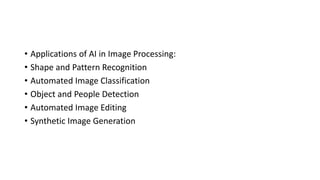Definition of Artificial Intelligence Importance of AI in Image Processing s
- 2. Introduction • Definition of Artificial Intelligence •Importance of AI in Image Processing
- 3. • Applications of AI in Image Processing: • Shape and Pattern Recognition • Automated Image Classification • Object and People Detection • Automated Image Editing • Synthetic Image Generation
- 4. AI Techniques in Image Processing: • Artificial Neural Networks • Convolutional Neural Networks • Deep Neural Networks • Deep Learning Techniques • Convolutional Layers
- 5. Practical Applications of AI in Image Processing •Medical Diagnosis •Space Imaging •Security Surveillance •Vehicle Instant Imaging •Aerial Imaging and Artificial Intelligence
- 6. Challenges and the Future •Continuous Improvement of Accuracy and Speed •Enhancing the Capability to Recognize Complex Objects and Conditions •Balancing Technology Utilization with Privacy and Security Concerns
- 7. Conclusion •Importance of AI Techniques in Developing Effective Image Processing Solutions •Future Potential and Expected Developments in the Field









